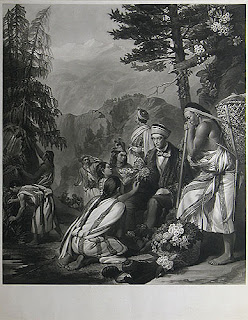Nature lovers may have seen this spectacular mezzotint featured recently on the BBCs Natural World episode The Himilayas.
This extremely rare engraving documents Dr. Joseph Dalton Hooker's famous expedition into the Himalayas.
A hugely important figure in the history of botanic science, and a close friend of Charles Darwin, Dr Hooker was the first European ever to collect plants from the Himalayas. He was Director of the Royal Botanic Gardens, Kew for twenty years and during his exploration of the Himilayas he sent back many previously unknown species of rhododendron, some
of which can be seen in Kew's Rhododendron Dell. His book The Rhododendrons
of Sikkim-Himalaya was followed by two volumes of Himalayan Journals
and The Flora of British India.
[Dr. Joseph Dalton Hooker, F.R.S. in the Rhododendron Region of the Himalaya Mountains]
William Walker after Frank Stone
Mezzotint
[c.1854]
Image 567 x 479 mm, Plate 682 x 560 mm, Sheet 780 x 610 mm
Finished proof before all letters.
Dr. Hooker seated and looking
to the left, is offered gifts of Rhododendrons by the kneeling female
figures surrounding him. A man stands to the right surveying the scene,
whilst in the distance the Himalayas can be seen.
Sir Joseph
Dalton Hooker (1817 - 1911) was a British botanist. The son of Sir
William Jackson Hooker, he became director of the Royal Botanic Gardens,
Kew (1865-1885) following the death of his father.
William
Walker the Younger (1791 - 1867) was an engraver, mezzotinter and
publisher. Born in Scotland and trained in Edinburgh, Walker moved to
London to work for Thomas Wollnoth. In 1829 he married Elizabeth
Reynolds, the daughter of Samuel William Reynolds I. They had a son who
was also named William Walker. It is thought that the Alexander Walker
publishing from 3 King Street is also related.
O’Donoghue (not recorded)
Ex. Col.: Hon. Christopher Lennox-Boyd

No comments:
Post a Comment